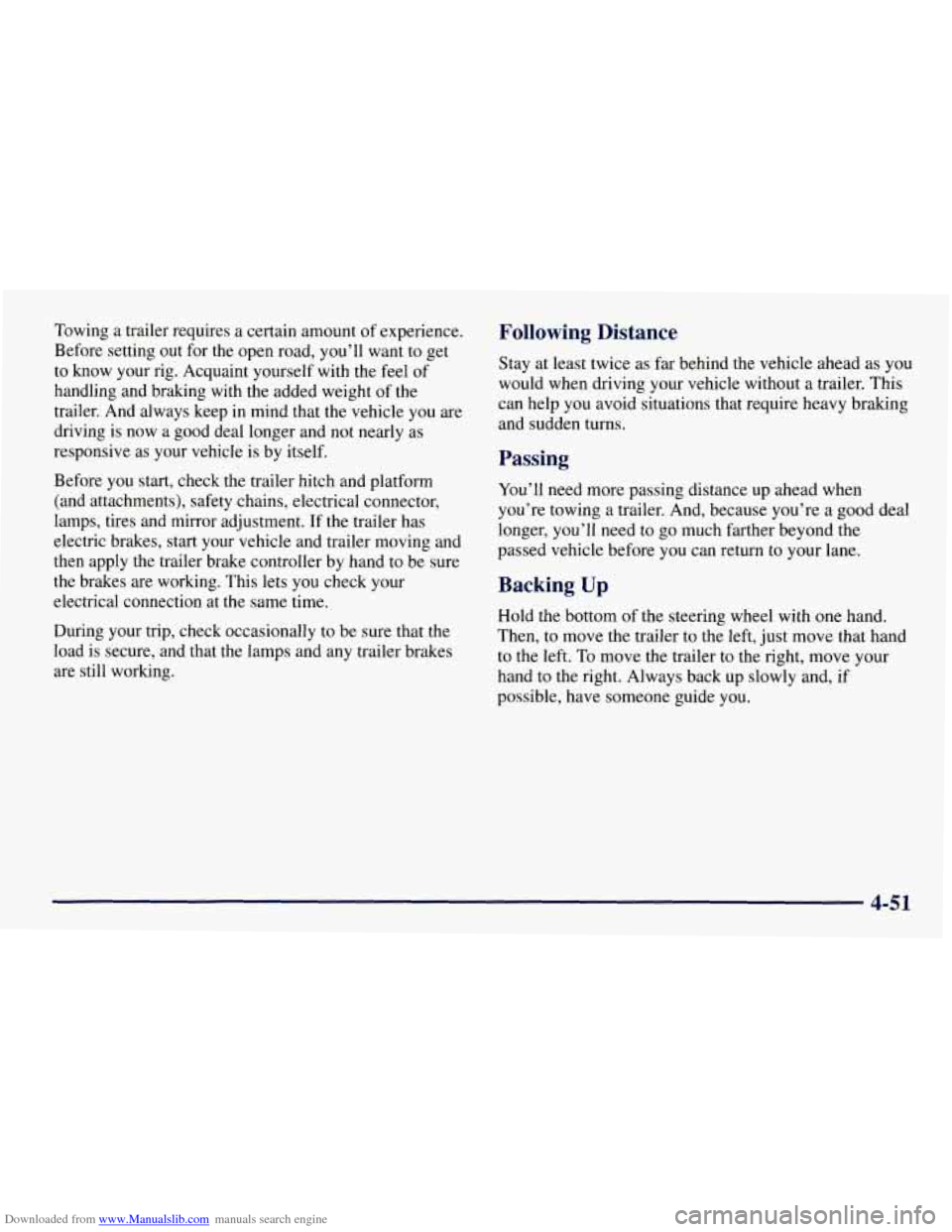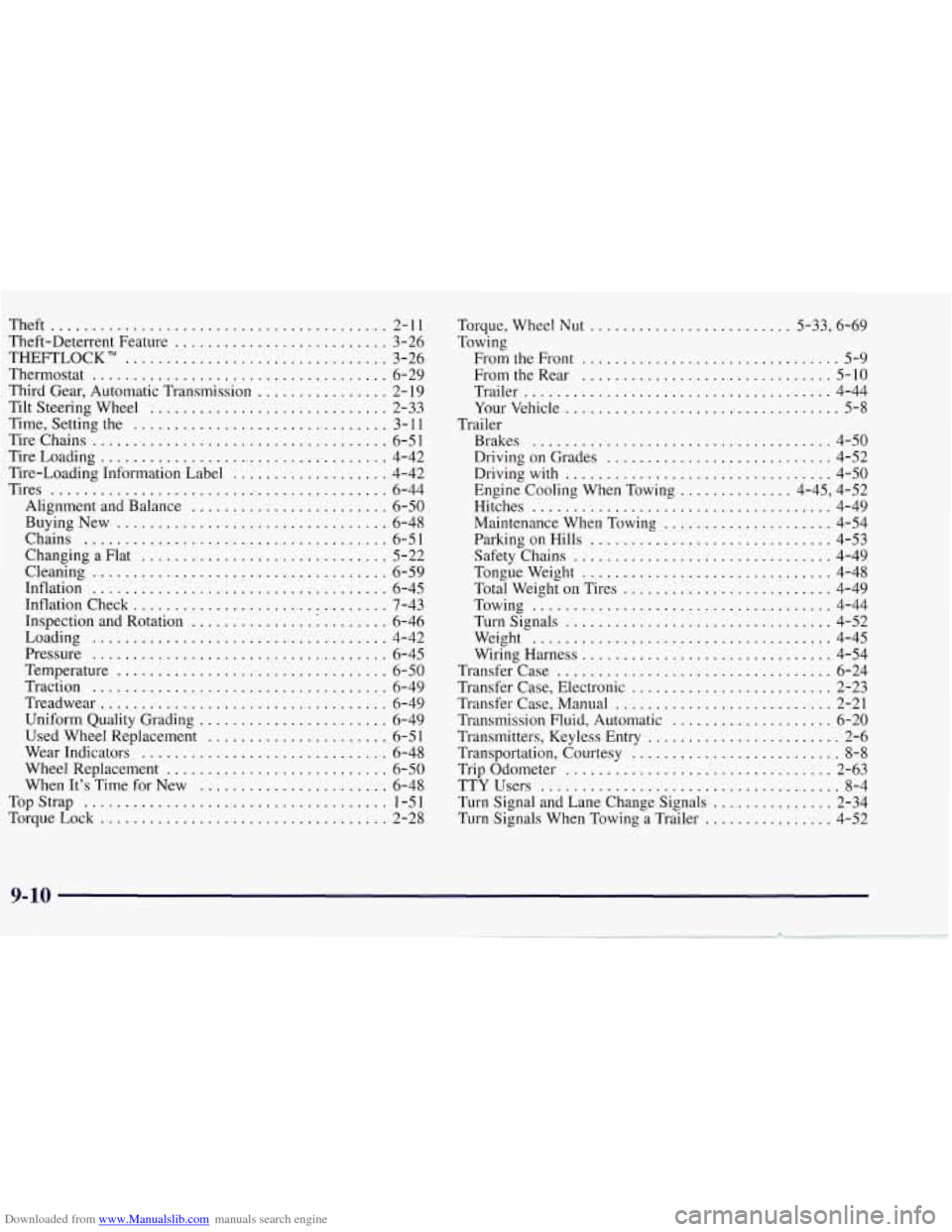1997 CHEVROLET TAHOE weight
[x] Cancel search: weightPage 227 of 433

Downloaded from www.Manualslib.com manuals search engine You can ask your dealer for our trailering information or
advice, or you can write
us at the address listed in your
Warranty and Owner Assistance Information Booklet.
In Canada, write to:
General Motors of Canada Limited
Customer Communication Centre
1908 Colonel Sam Drive
Oshawa, Ontario
LlH 8P7
Weight of the Trailer Tongue
The tongue load (A) of any trailer is an important
weight
to measure because it affects the total or gross
weight of your vehicle. The Gross Vehicle Weight
(GVW) includes the curb weight of the vehicle, any
cargo
you may carry in it, and the people who will be
riding in the vehicle. And if you will tow a trailer, you
must add the tongue load to the GVW because your
vehicle will be carrying that weight, too. See “Loading
Your Vehicle” in the Index for more information about
your vehicle’s maximum load capacity.
B
If you’re using a weight-carrying hitch, the trailer
tongue (A) should weigh
10 percent of the total loaded
trailer weight
(B). If you’re using a weight-distributing
hitch, the trailer tongue
(A) should weigh 12 percent of
the total loaded trailer weight
(B).
After you’ve loaded your trailer, weigh the trailer and
then the tongue, separately, to see if
the weights are
proper. If they aren’t, you may be able to get them right
simply by moving some items around in the trailer.
Page 228 of 433

Downloaded from www.Manualslib.com manuals search engine Total Weight on Your Vehicle’s Tires
Be sure your vehicle’s tires are inflated to the upper
limit for cold tires. You’ll find these numbers on the
Certification label at the rear edge of the driver’s door or
see “Tire Loading’’ in the Index. Then be sure you don’t
go over the GVW limit for your vehicle, including the
weight of the trailer tongue.
Hitches
It’s important to have the correct hitch equipment.
Crosswinds, large trucks going by and rough roads are
a
few reasons why you’ll need the right hitch. Here are
some rules to follow:
If you use a step-bumper hitch, your bumper could
be damaged in sharp turns. Make sure you have
ample room when turning to avoid contact between
the trailer and the bumper.
If you’ll be pulling a trailer that, when loaded, will
weigh more than the capacity stamped on your step
bumper, be sure to use a properly mounted,
weight-distributing hitch and sway control of the
proper size. This equipment is very important for
proper vehicle loading and good handling when
you’re driving.
Will you have to make any holes in the body of your
vehicle when you install a trailer hitch?
If you do, then be sure to seal the holes later when
you remove the hitch. If you don’t seal them, deadly
carbon monoxide (CO) from your exhaust can get
into your vehicle (see “Carbon Monoxide”
in the
Index). Dirt and water can, too.
Safety Chains
You should always attach chains between your vehicle
and your trailer. Cross the safety chains under the tongue
of the trailer so that the tongue will not drop to the road
if
it becomes separated from the hitch. Instructions
about safety chains may be provided
by the hitch
manufacturer or
by the trailer manufacturer. Follow the
manufacturer’s recommendation for attaching safety
chains and do not attach them to the bumper. Always
leave just enough slack
so you can turn with your rig.
And, never allow safety chains to drag
on the ground.
4-49
Page 230 of 433

Downloaded from www.Manualslib.com manuals search engine Towing a trailer requires a certain amount of experience.
Before setting out for the open road, you’ll want to get
to know your rig. Acquaint yourself with the feel of
handling and braking with the added weight of the
trailer. And always keep
in mind that the vehicle you are
driving is now a good deal longer and not nearly as
responsive as your vehicle is by itself.
Before you start, check the trailer hitch and platform
(and attachments), safety chains, electrical connector,
lamps, tires and mirror adjustment. If the trailer has
electric brakes, start your vehicle and trailer moving and
then apply the trailer brake controller by hand to be sure
the brakes are working. This lets
you check your
electrical connection at the same time.
During your trip, check occasionally to be sure that the
load
is secure, and that the lamps and any trailer brakes
are still working.
Following Distance
Stay at least twice as far behind the vehicle ahead as you
would when driving your vehicle without a trailer. This
can help you avoid situations that require heavy bralung
and sudden turns.
Passing
You’ll need more passing distance up ahead when
you’re towing a trailer. And, because you’re a good deal
longer,
you’ll need to go much farther beyond the
passed vehicle before
you can return to your lane.
Backing Up
Hold the bottom of the steering wheel with one hand.
Then, to move the trailer to the left, just move that hand
to the left.
To move the trailer to the right, move your
hand to the right. Always back up slowly and, if
possible, have someone guide you.
4-51
Page 426 of 433

Downloaded from www.Manualslib.com manuals search engine Gear Positions. Automatic Transmission ............. 2- 16
Gross Axle Weight Rating
........................ 4-42
Gross Vehicle Weight Rating
...................... 4-42
Guide en Franqais
11
GloveBox .................................... 2-48
.. .................................
GVWR ....................................... 4-42
Halogen Bulbs
................................ 6-37
Hazard Warning Flashers
.......................... 5-2
Head Restraints
................................. 1-6
Headlamps .................................... 2-40
Bulb Replacement
.................. 6-37,6-38, 6-67
High/Low Beam Changer
...................... 2-34
On Reminder
................................ 2-41
Wiring
..................................... 6-62
Hearing Impaired, Customer Assistance
.............. 8-4
Heating
........................................ 3-8
High-Beam Headlamps
.......................... 2-34
Highway Hypnosis
.............................. 4-35
Hill and Mountain Roads
......................... 4-36
Hitches, Trailer
................................. 4-49
Hood Checking Things Under
......................... 6-8
Release
...................................... 6-9
Horn
......................................... 2-33
Hydroplaning
.................................. 4-31
Ignition Positions
.............................. 2- 12
Ignition Transmission Lock Check
................. 7-46
Illuminated Entry
............................... 2-42
Inflation, Tire
.................................. 6-45
Inside Rearview Mirror
.......................... 2-44 Inspections
.................................... 7-47
Brakesystem
................................ 7-48
DriveAxle
.................................. 7-48
Exhaust System
.............................. 7-47
Radiator and Heater Hose
...................... 7-47
Steering
.................................... 7-47
Suspension
.................................. 7-47
Throttle Linkage
.............................. 7-47
Transfer Case (Four-wheel Drive)
............... 7-48
Instrumentpanel
............................... 2-60
Brightness Control
............................ 2-42
Cleaning
.................................... 6-56
Cluster
..................................... 2-62
FuseBlock
.................................. 6-63
Interior Lamps
..................... ....... 2-42
Jack, Tire
............................... 5-24, 5-25
Jump Starting
................................... 5-3
Key Lock Cylinder Service
...................... 7-44
Keyless Entry System
............................ 2-6
Keys
............... .................... 2-2
Labels Certificatioflire
............................. 4-42
Service Parts Identification
..................... 6-61
Tire-Loading Information
...................... 4-42
Vehicle Identification Number
................... 6-61
9-5
Page 431 of 433

Downloaded from www.Manualslib.com manuals search engine Theft ................... ... 2-11
Theft-Deterrent Feature ...... ... ...... 3-26
THEFTLOCK
........................ ... 3-26
Thermostat
............................ ... 6-29
Third Gear, Automatic Transmission
................ 2- 19
Tilt Steering Wheel ............................. 2-33
Time. Setting the
............................... 3- 11
Tire Chains .................................... 6-5 1
TireLoading ................................... 4-42
Tire-Loading Information Label
................... 4-42
Alignment and Balance
........................ 6-50
BuyingNew
................................. 6-48
Chains
..................................... 6-51
Changing
a Flat .............................. 5-22
Cleaning
.................................... 6-59
Tires
......................................... 6-44
Inflation
.................................... 6-45
Inflation Check
............................... 7-43
Inspection and Rotation
............... 1 ........ 6-46
Loading
.................................... 4-42
Pressure
.................................... 6-45
Temperature ................................. 6-50
Traction
.................................... 6-49
Treadwear
................................... 6-49
Uniform Quality Grading
....................... 6-49
Used Wheel Replacement
...................... 6-51
Wear Indicators
.............................. 6-48
Wheel Replacement
........................... 6-50
When It’s Time for New
....................... 6-48
TopStrap
..................................... 1-51
TorqueLock ................................... 2-28 Torque.
Wheel
Nut ......................... 5.33. 6.69
From the Front
................................ 5-9
From the Rear
............................... 5-10
Trailer
...................................... 4-44
Yourvehicle
.................................. 5-8
Brakes
..................................... 4-50
Driving on Grades
............................ 4-52
Driving with
................................. 4-50
Engine Cooling When Towing
.............. 4-45, 4-52
Maintenance When Towing
..................... 4-54
Safety Chains
................................ 4-49
Tongueweight
............................... 4-48
Total Weight on Tires
.......................... 4-49
Towing
..................................... 4-44
Turnsignals
................................. 4-52
Weight
..................................... 4-45
Wiring Harness
............................... 4-54
Transfer Case
.................................. 6-24
Transfer Case, Electronic
......................... 2-23
Transfer Case, Manual
........................... 2-21
Transmission Fluid, Automatic
.................... 6-20
Transmitters, Keyless Entry
........................ 2-6
Transportation, Courtesy
.......................... 8-8
Trip Odometer
................................. 2-63
Turn Signal and Lane Change.Signals
............... 2-34
Turn Signals When Towing
a Trailer ................ 4-52
Towing
Trailer Hitches
..................................... 4-49
Parking
on Hills .............................. 4-53
TTYUsers
..................................... 8-4
9-10